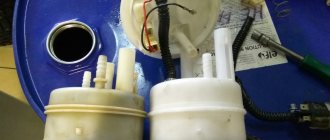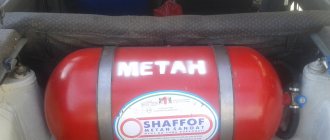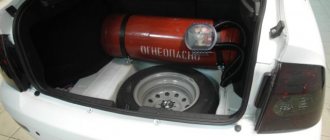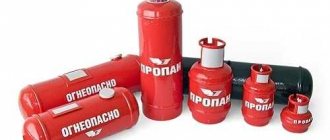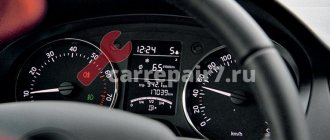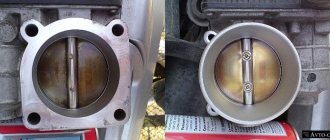When using methane, the car does not lose much in acceleration dynamics compared to driving on gasoline. However, you don’t expect easy and fast overtaking on the highway from an ordinary Largus. It feels like acceleration to 100 km/h in Largus on methane lasts a couple of seconds longer than in the gasoline version. Official manufacturer data: 14.4 seconds on methane and 13.4 seconds on gasoline. Contrary to the myth that exists among motorists, there are no differences in the ratio of crankshaft revolutions and vehicle speed when using different fuels. And it cannot be. The engine spins up to 3000 rpm at a speed of almost 120 km/h. Of course, when overtaking on the highway, no, no, and you’ll switch to a lower gear. In this case, the gas mixture begins to be enriched with gasoline. This is done to reduce the thermal effect on the engine. In addition, the engine always starts on gasoline. It is these two modes of operation of the power unit that add several rubles spent on gasoline to the cost of a kilometer of travel on methane.
How many cubic meters of methane gas are in an 80 liter cylinder?
That is, if you chose an 80 liter methane cylinder, then it will fill 20 “cubes” of methane.
Interesting materials:
How to return white color to shoe soles? How to return white color to grayed things? How to return white things to their snow-white appearance? How to restore the former softness of terry towels? How to get a sweater back into shape? How to return the state duty from the court of the Republic of Kazakhstan? How to return the state fee paid to the court? How to return Instagram to Russian? How to bring a cast iron frying pan back to life? How to bring an old cast iron frying pan back to life?
Fuel consumption
During the trip, the car was operated in “highway” mode, close to mixed. Yes, the route was mostly intercity, but it is also worth taking into account the settlements that we had to visit. In addition, there were many sections along the way where the road was being repaired (in the Penza and Ryazan regions).
|
Methane prices in our country vary from 14 to 16 rubles per cubic meter. m. |
We managed to drive 295 kilometers on methane before switching to gasoline. The cost per kilometer was almost 1 ruble. For comparison, in a similar mode, Largus consumes about 8 liters of gasoline per hundred. With the cost of gasoline being 42 rubles per liter of 92, each kilometer of the journey will cost 3 rubles.
WHY METHANE AND NOT PROPANE. I’ll explain so you don’t torment me with advice.
This is not the first time I’ve heard that propane could have been installed cheaper, there would have been more space in the trunk, etc. As a rule, those who are not in the know advise. People! I gave myself all these arguments more than once while I was deciding what to install: METHANE or PROPANE. Well, we are not so rich that we can buy something more expensive out of idleness. And not so economical that without noticing the real benefit, you quickly grab something that is inexpensive. I’ll say right away that in all my cars, except diesel and Japanese right-hand drive, I had propane everywhere. The last Volga had fourth generation Italian equipment. And when I worked in a taxi, there was methane in my owner’s cars. So I knew what it was about.
Methane outweighed, and why? I'll tell you in order. You and I live in a country where everyone strives to deceive their neighbor, and at every step. Comparing with the last Volga, I can give an example of how I was repeatedly filled with 53-55 liters of gas into a 50-liter cylinder, this is the easiest prank of the tankers. But sometimes they fill it with something unknown, after which, in the best case, the gas filters are changed, and in the worst case, all the rubber membranes are completely replaced, not counting the downtime of the technician. Plus, propane consumption is with a coefficient of 1.2 compared to gasoline, and for methane it is 0.8-0.9 (exclusively from the words of the master). Those. Propane consumption is more than gasoline, and methane consumption is slightly less. And they use chemicals because propane is a liquefied gas, and methane is compressed; it is also not so demanding on cold starts. Again, at the time of my thoughts, gasoline cost 25 rubles, propane 16 rubles, and methane 8 rubles. And therefore, when consuming 12-13 liters of gasoline in the city in the summer and with the climate, we get 25 * 12 = 300 rubles / 100 km = 3 rubles / 1 km and even more. On propane, taking into account that the consumption is higher than on gasoline: 13 * 16 = 208 rubles / 100 km = 2 rubles / 1 km. And on methane, even 12 * 8 = 96 rubles / 100 km, in fact it’s really less. Here's the whole layout: 3-2-1. I can’t explain it any simpler or more accessible. From these figures, anyone can understand that savings on propane are 1 ruble/1 km, and on methane 2 rubles/1 km. Considering that gasoline has become more expensive, the difference is even greater. True, propane has become a little cheaper. Based on this, upon reflection, I calculated that if the latest generation propane costs approximately 20,000 rubles, and methane 40,000 rubles, then they will pay for themselves in the same 20,000 km. True, I now have an increase in price due to the added cylinder, so it will pay off in 30,000 km. It even makes sense to re-borrow money; it still pays off quickly.
And therefore: I don’t need any advice, that I could just stuff in a “bagel” and everyone would be happy! I consciously went for it, because... We load the trunk only during long trips into nature. But I don’t carry bags around the place and around the city. This means that if we need to load a lot three or four times a year, then somehow we’ll make room and fit in. But the remaining 360 days a year, I can very comfortably transport myself or, for example, my daughter to school and back. At this time, it doesn’t matter to us how much space there is in the trunk! After all, people drive Matiz cars and they like them, but they didn’t even make a trunk there at the factory.
That's who needs propane, please. And I am satisfied with everything, but at the same time I am in no way imposing my opinion, but simply sharing my impressions. Good luck on the road!
Cost of installing gas equipment and fuel
Installing gas equipment allows you to significantly save money due to the low cost of fuel (gas is almost 2 times cheaper than gasoline).
Let's give an example. Let's say you drive 100,000 km per year. With a gasoline consumption of 10 liters per 100 km, gas consumption will be approximately 10% more, for a total of 11 liters of gas per 100 km. The price of gasoline in 2022 is 43.5 rubles/l, propane 21 rubles/l, methane 15 m3/l.
| Gas type | Fuel price | Average installation cost for 4 cylinders | Monthly savings | Annual Savings |
| Propane | 21 rub./l. | 27,000 rub. | RUB 16,930 | RUR 203,185 |
| Methane | 15 rub./m3 | 60,000 rub. | RUB 22,410 | 269,000 rub. |
Check out the savings!
After the payback period ends, HBO will begin to save your money. Over the course of a year of operating a converted car, you will save:
- for Hyundai Sonata – 86,400 rubles;
- for PAZ-32050R – 672,210 rubles;
- for KAMAZ-4308-N3 – 19,360 rubles;
- for Gazelle – 178,500 rubles.
- for Hyundai Solaris – 148,750 rubles.
LPG installed by professionals will significantly reduce the cost of operating your car!
“Order installation calculation”
Comparison of two types of fuel
There are significant differences between gases. This applies to storage and operation (use). Applicable to vehicles:
- Methane is an environmentally friendly natural gas, produced in deposits from the bowels of the earth. Cars with methane gas equipment are marked - CNG (Compressed Natural Gas) compressed natural gas or CNG (compressed);
- Propane-butane is a mixture of two gases obtained from the oil industry. Marking LPG (Liquified Petroleum Gas) or CIS (liquefied petroleum gas).
Storage and transportation of methane as automobile fuel is carried out under a pressure of 200-250 atmospheres (measured in cubic meters), propane-butane 14-18 atmospheres. (in liters). Both types of fuel are widely used in passenger cars, trucks, passenger vehicles and agricultural machinery. In internal combustion engines: gasoline, diesel (gas diesel), gas.
Let's consider the main pros and cons of cars running on methane and propane, in such indicators as:
- Price and design differences between gas equipment.
- Financial and economic benefits.
- Motor characteristics.
- Safety.
- Availability of gas stations.
- Issues related to ecology.
Differences between methane gas and propane gas
The cost and installation of gas equipment running on propane will be cheaper than installing gas equipment on methane. The numbers are impressive, the difference in price can be a colossal gap. For example, a 4th generation propane gas installation for a passenger car can cost on average from 25-35 thousand rubles. from 60 thousand rubles in the cheapest version . With commercial vehicles it is even more complicated.
The main contribution to the difference is the price of gas cylinders and their installation. And if this fact is applied to powerful cars or trucks, where more than one or two cylinders are installed, then the conversion will cost a tidy sum.
Since methane gas is compressed under high pressure, thick-walled, heavy containers are required for its transportation. In addition, methane vessels are only cylindrical in shape, which can make it difficult to choose a place for installation and take up the useful volume of the luggage compartment. In terms of mass, there is an alternative solution - composite cylinders of different sizes, but their price is too high (for example, an 80-liter vessel will cost from 35,000 rubles complete with shut-off valves and fasteners).
Propane is more profitable in this regard - there is a huge selection of relatively light, cheap toroidal (for the spare wheel niche) or cylindrical cylinders.
The gas reducer and fuel lines are also different (for methane they use metal ones with a protective coating, again due to pressure). Propane gas equipment uses copper or plastic. A pressure gauge is installed with the CNG reducer to control the pressure and, as an option, an electronic sensor with an indication output to the passenger compartment - a gas fuel meter.
Methane equipment has its own filling device. Otherwise, gas systems are similar.
Gas consumption and payback
When comparing and choosing which gas equipment to install on a car, methane or propane, first of all they consider the payback period of the equipment.
For obvious reasons, it is difficult to calculate the exact economics within the framework of this article (jumps in prices for fuel and equipment, vehicle features, depreciation). Therefore, we will make an average calculation, where everyone, knowing the parameters of their car, can substitute them, obtaining more specific figures.
- the price of gasoline is 43 rubles, propane is 20 rubles, methane is 17 rubles;
- mileage per month 3000 km;
- car (ICE 4 cylinders, gasoline, gasoline consumption per 100 km run 10 liters - 12,900 rubles per month);
- cost of gas equipment: propane 30,000 rubles, methane 60,000 rubles.
It is believed that the consumption of propane-butane in relation to gasoline is 10-35% higher. Let’s take the maximum value – 35%, so the consumption coefficient relative to gasoline will be 1.35. It turns out that with propane the consumption per hundred will be 13.5 liters. 405 l per month. gas – 8100 rub. Benefit 37% or 4800 rubles.
Methane is measured in cubic meters, its consumption compared to gasoline is on average 10% less (derived experimentally) - coefficient. 0.9. In our case – 9 m3. At the end of the month, 270 cubic meters - 4590 rubles. Almost 65% more profitable or 8310 rubles.
1. CIS (gas cost/benefit): 30,000/4800= 6.25 months or (recoupment*mileage): 6.25*3000= 18,750 km. mileage ;
2. CNG – 60000/8310=7.22 months. or – 7.22*3000= 21661 km.
Effect of gas engine fuel on the engine
Gas in the engine burns slower than gasoline, since the octane number of methane is 120, and the propane-butane mixture is about 105. For this reason, temperature loads appear on the exhaust tract, loss of power and increased fuel consumption.
These problems are solved by installing an ignition angle advance variator (on some brands the firmware of the LPG controller is done). Installation on methane and propane is recommended.
According to numerous reviews from drivers, no matter how you set up your car on methane, the dynamic characteristics of the engine are still reduced by about 10%.
Another advantage of methane is the fact that the gas itself is much cleaner than LPG. Accordingly, gas equipment is simpler and cheaper to maintain. In addition, during winter operation there are no problems with freezing condensate. The disadvantage will be a smaller number of service stations dealing with CNG. With propane the situation is the opposite.
Safety
When propane leaks, the gas concentrates at the bottom, from this point it is more fire hazardous. Methane, on the other hand, dissolves very quickly in the air. But if the leak occurs in an open space, you don’t have to worry. In a closed room - expect trouble.
There are numerous stories about the explosion of methane cylinders, but these cases are largely due to untimely control of installed equipment and ignoring the requirements for re-examination of containers.
Refueling and range
Long-distance country trips are contraindicated on methane - this is true. CNG filling stations are more exotic than reality. They are sorely lacking and the location is inconvenient. And an 80-liter vessel, one of the most common options for a passenger car, contains 19 m3 of methane (about 200 km of travel).
Read also: Changing the oil in the transfer case
Under certain circumstances, there is a solution to this issue. You can refuel your personal car using an individual home compressor (mini CNG filling station, CNG filling station). But the price for it is around 350-500 thousand rubles, although gas will cost more than half as much.
The propane gas station network is very extensive; you can refuel almost anywhere. But the quality of the CIS often leaves much to be desired.
Another minor, but negative, is that the CNG download process takes a little longer.
Ecology
This indicator is the last thing that interests car enthusiasts, but in environmental terms there are practically no complaints about methane. It is much cleaner than its competitor, which contains a fairly large amount of harmful impurities. When methane is burned, there are almost no environmental pollutants. In modern megacities this issue is very relevant.
Safety of propane and methane
If we talk about the safety of gas fuel, it is important to emphasize that high-quality installation of good equipment makes LPG cars as safe as gasoline cars.
If we compare the safety of these two types of gas, the safety level of methane is twice as high as propane. Methane has safety class 4, when propane class 2. But don’t worry, because propane cylinders must be equipped with a multi-safety valve with fire, high-speed and solenoid valves in accordance with UNECE rules No. 67(01). They are responsible for stopping the supply of gas to an idle engine.
Methane as an alternative fuel for trucks. characteristics.
More and more commercial vehicles began to appear on gas (namely Methane). but nowhere have I found an understandable scheme for calculating the efficiency of this gas in comparison with diesel. a little about gas (no matter what they write here about propane) https://ru.wikipedia.org
Compressed natural gas (compressed natural gas) is compressed natural gas used as a motor fuel instead of gasoline, diesel fuel and propane.
. It is cheaper than traditional fuel, and the greenhouse effect caused by its combustion products is less compared to conventional fuels, so it is safer for the environment. Compressed natural gas is produced by compressing natural gas in compressor units. Storage and transportation of compressed natural gas takes place in special gas storage tanks under a pressure of 200-220 bar. Biogas is also added to compressed natural gas, which reduces carbon emissions into the atmosphere.
Compressed natural gas as a fuel has a number of advantages: * Methane (the main component of natural gas) is lighter than air and in the event of an emergency spill it quickly evaporates, unlike heavier propane, which accumulates in natural and artificial depressions and creates the risk of explosion. * Non-toxic in low concentrations; * Does not cause corrosion of metals. * Compressed natural gas is cheaper than any petroleum fuel, including diesel, but exceeds them in calorie content. * Low boiling point ensures complete evaporation of natural gas at the lowest ambient temperatures. * Natural gas burns almost completely and does not leave soot, which worsens the environment and reduces efficiency. The exhaust flue gases do not contain sulfur impurities and do not destroy the metal of the chimney. from me


